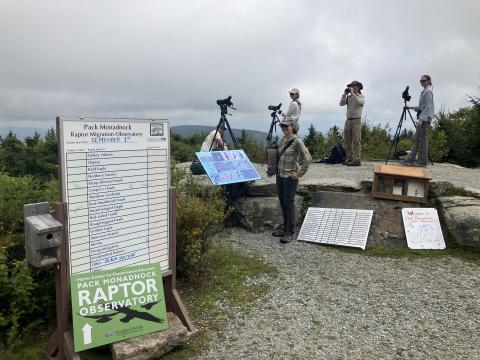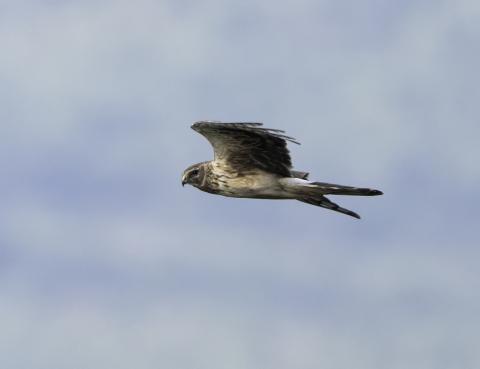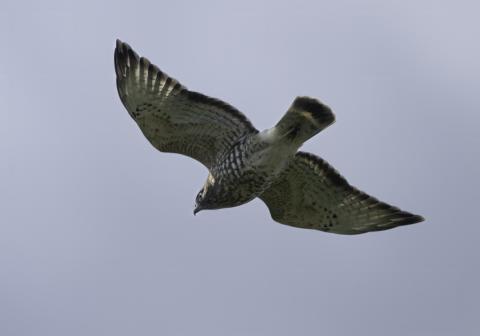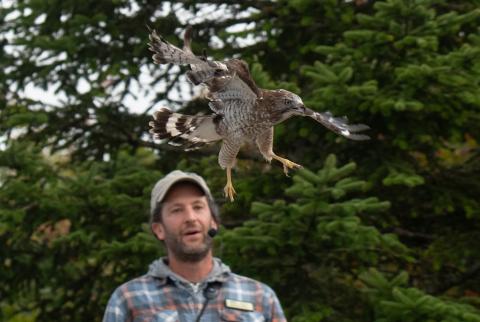Fall Migration at the Pack Monadnock Raptor Observatory
Each autumn, thousands of raptors make annual journeys across New Hampshire’s forested landscapes to wintering grounds further south. Though they can be viewed from many of the state’s granite summits and higher hilltops, no place is celebrated as widely for this spectacle as the top of Pack Monadnock Mountain in Peterborough in Miller State Park, home of NH’s only full-time seasonal hawk watch.
For 20 consecutive years, groups including the Harris Center have observed and tallied the fall raptor migration at a north-facing granite outcrop here known as the Pack Monadnock Raptor Observatory. Each raptor matters in this count as annual tallies from the Observatory help inform global raptor population estimates. While biologists, educators, and a team of volunteers are focused largely on the raptors, their identifications, and the science this work supports, equal attention is paid to the 6,000 spectators visiting the Observatory each fall. This figure includes dozens of school groups from preschool to graduate schools who come to learn about the science and spectacle of raptor migration.

The Observatory, in partnership with NH Parks and Division of Parks and Recreation, is staffed by either a lead raptor counter or volunteers each day between September 1st and November 20th. Photo by Phil Brown.
Hawk watching has seen an evolution in this country from just decades ago when some raptor species were considered ‘vermin’ and shot for sport to one in which they are beloved symbols of survival through their recovery from both shooting and the DDT era, which threatened several species – like the Bald Eagle and Peregrine Falcon – with extinction. Today, shooters have been replaced by enthusiasts with binoculars at hundreds of lookout points across the Americas. Amateur and professional watchers are part of a vast monitoring network of hawk watch sites under the umbrella of the Hawk Migration Association, which hosts the Hawkcount.org database – a powerful tool used to determine raptor population trends of dozens of raptor species.
For decades, if not many centuries, humans have been fascinated with the spectacle of raptor migration. An early account of the fall raptor migration from along the Connecticut River between NH and VT during the Revolutionary War period details the ‘squadrons’ of hawks filling the sky in late September, and pre-Colombian rituals in Mexico and Central America seem to honor this annual spectacle further south. Why do raptors fascinate many of us? Perhaps because they are fierce predators, or maybe because they’re stealthy and speedy. Ask any class of elementary school-aged students their favorite bird and you’ll see how many votes are cast for Peregrine Falcon, the ‘fastest animal on Earth'. Or maybe it’s how accessible raptors are compared to other birds. Many are large, some are frequently seen along roadways, and others even make frequent appearances at backyard bird-feeding stations. Could it be that they embody the sense of freedom we all long for – the ability to fly, with such ease and grace? During fall migration, some can be enjoyed flying overhead in astounding numbers. Most notably, the Broad-winged Hawk, a common but stealthy summer resident of the state, makes an awe-inspiring mass exodus as its entire North American population vacates to central and South America to spend the nonbreeding season in rainforest and cloud forest habitats! In the Northeast, this species fills the skies during mid-September as hundreds or even thousands travel together on peak days. They gather not for social reasons but instead for the thermals of warm air currents that rise and provide the lift these birds need to travel so far.
Thermals and updrafts are two important mechanisms for raptor migration, but they’re not the only ones. Each of the 15 or so species observed during migration possesses a different strategy, timing, or habitat niche that allows each to specialize. From the fish-eating Osprey to the forest-dwelling Sharp-shinned Hawk to the open-country specialist American Kestrel, raptors are full of variety and diverse natural history strategies. Likewise, they are distinguished by their differences – in plumage, coloration, shape, size, and behavior – as they soar or wing their way across the sky.
As late fall comes, the days have shortened and become cooler, and the migration window begins to close for many species. However, certain weather will bring exciting days that avid hawk watchers describe as ones that possess ‘quality over quantity’. The bright foliage has faded and fallen away, but after the passage of a cold front when the winds shift to the west, you may luck out and strike gold – as in Golden Eagles. These infrequent large visitors from a small breeding population in eastern Canada delight the hardiest of hawk watchers who brave chilly cold fronts and gusty west winds. There are other treats, too, such as the fierce American Goshawk, dainty Northern Harrier, attractive Red-shouldered Hawk, and a sizeable count of the well-known Red-tailed Hawk, one of the season’s latest migrants.

A female Northern Harrier, a state-endangered breeding raptor in NH, migrates past the Observatory. Though this species has seen a decreasing trend, over 100 are counted in some seasons. Photo by Chuck Carlson.

A Broad-winged Hawk migrates over the Observatory. This most commonly counted species migrates in large flocks known as 'kettles', sometimes containing several hundred birds at a time. Photo by Chuck Carlson.
In the fall, look for raptors from summits and hilltops with an open, north-facing view following cold fronts. While autumn is the best time to witness the largest numbers of raptors migrating across NH, it’s not the only time to view them. Spring migration can be seen along the coast, river valleys, and hilltops (facing south is best in spring). In winter, look for raptors in open landscapes and concentrated around open water (eagles).

A rehabilitated adult Broad-winged Hawk gets a second chance at life in the wild at the Observatory's annual Raptor Release Day as Phil Brown looks on. The bird is one of many taken in and cared for by Wings of the Dawn, a wildlife rehabilitation center, based in Henniker, NH. Photo by Judd Nathan.
The Harris Center partners with Miller State Park and the NH Department of Natural and Cultural Resources, Division of Parks and Recreation, to operate the Observatory. The Observatory relies on various funding sources, especially private contributions. For more about the Observatory, including how to plan your visit, see https://harriscenter.org/conservation-research/pack-monadnock-raptor-observatory.
Stay updated on the migration, special events, and more in periodic Field Reports https://harriscenter.org/conservation-research/pack-monadnock-raptor-observatory/hawk-migration-field-reports available on the Harris Center’s website.
Visit the Hawk Migration Association’s websites www.hmana.org and www.hawkcount.org to learn more about the role of hawk watching and to gain a broader perspective of raptor migration across the Americas.


